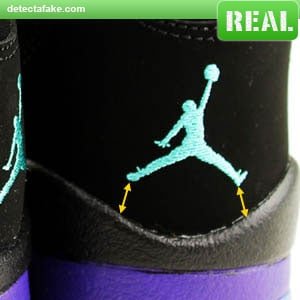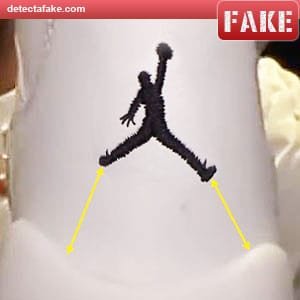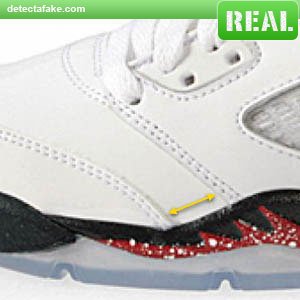How to Spot fake Nike Air Jordan V
Are you a proud owner of Nike Air Jordans, or are you considering joining the ranks of those who flaunt this iconic footwear? With their inception in 1984, initially crafted for the legendary Michael Jordan and later released to the public in 2001, Air Jordans have undeniably become a symbol of style and athleticism. However, as their popularity soars, so does the prevalence of counterfeit versions flooding the market. How can you be sure your Jordans are the real deal? Let’s dive into the details.
Table of Contents
| Sr# | Headings |
|---|---|
| 1 | Authenticity Check: Factory Codes and Box |
| 2 | Tongue Height: The Telltale Sign of Genuine Jordans |
| 3 | The Mystery of the “23”: Real vs. Fake |
| 4 | Examining the Jumpman on the Back |
| 5 | Jumpman’s Dance: Position Matters |
| 6 | Jumpman on the Tongue: A Height Analysis |
| 7 | Give it a Press: Assessing Side Cushion Authenticity |
| 8 | Toe Box Talk: Width Matters |
| 9 | Underneath the Sneakers: Decoding the Bottom Jumpman |
| 10 | Lace Lock Logic: Spotting Genuine Features |
| 11 | Stitching Quality: The Devil is in the Details |
| 12 | A Stitch in Time: Examining Waffle-Like Patterns |
1. Authenticity Check: Factory Codes and Box


When you first get your hands on a pair of Air Jordans, examine the tag for factory codes LN3 (China) or FT1 (Taiwan). Ensure that the manufacturing country on the box matches the one on the tag.
2. Tongue Height: The Telltale Sign of Genuine Jordans


A quick glance at the tongue can reveal a lot. Genuine Jordans have a tongue height that extends close to the top of the shoe, unlike their fake counterparts which fall short.
3. The Mystery of the “23”: Real vs. Fake


For those with the iconic “23” on the side, inspect the gap between the “2” and “3.” Authentic Jordans boast a clear space, while counterfeits often display sloppy embroidery, connecting the digits.
4. Examining the Jumpman on the Back


The back of the shoe reveals a lot about authenticity. A real Jumpman exhibits uniform fingers and a flat hand, while a fake one lacks the finesse, standing out in quality.
5. Jumpman’s Dance: Position Matters


Pay attention to the space between the Jumpman’s feet and the sole. Authentic Jordans maintain a proportionate distance, while fakes often exaggerate this gap.
6. Jumpman on the Tongue: A Height Analysis


The height of the Jumpman on the tongue is critical. A genuine pair showcases a clear space between the outline and the top of the tongue, whereas a fake one may lack this distinction.
7. Give it a Press: Assessing Side Cushion Authenticity


A genuine pair bounces back to its original shape swiftly when you press on the side cushion. In contrast, fake ones may take a moment to regain their form.
8. Toe Box Talk: Width Matters


Examine the width between stitching on the toe box. Genuine Jordans maintain a specific spacing, while counterfeits often have wider gaps.
9. Underneath the Sneakers: Decoding the Bottom Jumpman


Inspect the Jumpman on the bottom of the shoe, checking for arm width, toe positioning, and leg spread. Discrepancies here can indicate a fake pair.
10. Lace Lock Logic: Spotting Genuine Features


A genuine lace lock should feature the Jumpman, not “NIKE” molded into it. However, be cautious; genuine lace locks are sold separately, so it’s crucial to combine this check with others.
11. Stitching Quality: The Devil is in the Details


Authentic Jordans boast uniform stitching with no extra material beyond the stitches. Counterfeits often reveal inconsistencies in this area.
12. A Stitch in Time: Examining Waffle-Like Patterns

Quality stitching is crucial. Authentic Jordans showcase a consistent waffle-like pattern along the stitch line, while fake ones may exhibit uneven and irregular stitching.
Ensuring the authenticity of your Nike Air Jordans is a meticulous process. By carefully examining factory codes, tongue height, Jumpman details, and more, you can confidently distinguish between the genuine and the counterfeit. Remember, the devil is in the details, so scrutinize every aspect to make sure your Air Jordans are the real deal.
Frequently Asked Questions (FAQs)
Q1: How can I verify the authenticity of the factory codes on my Jordans? A1: Check for LN3 (China) or FT1 (Taiwan) stamped on the tag and ensure the manufacturing country on the box matches.
Q2: Do all Jordan 5 retros have the “23” on the side? A2: No, not all of them do. If yours does, examine the gap between the digits for authenticity.
Q3: Can lace locks alone confirm the authenticity of my Jordans? A3: No, genuine lace locks can be bought separately. Combine this check with others for a comprehensive assessment.
Q4: Is stitching quality a reliable indicator of authenticity? A4: Yes, authentic Jordans have uniform stitching with no extra material beyond the stitches.
Q5: Why is the tongue height crucial in determining authenticity? A5: Genuine Jordans have a distinctive tongue height that counterfeit versions often fail to replicate accurately.
